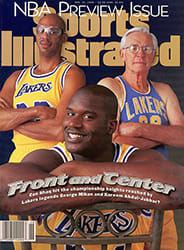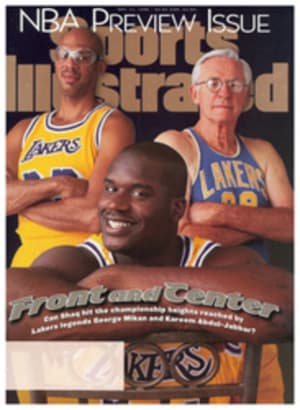Lakers centers pivotal to the pro game's evolution
A half-century of centers assembled under one basket, elbows instinctively deployed, shoulders square to the hoop, eyes on the ball. It's a posed shot, except that they can't help leaning into each other. Almost everything has changed in 50 years--as you move forward in Lakers history, each center has more and more "people," and his "people" have thinner and thinner cell phones--except the battle for position. The photographer poses them for this intergenerational portrait, and the three centers, representing a sustained arc of achievement, quietly jockey under the lights, pressing, pushing. They can't help it.
George Mikan to Kareem Abdul-Jabbar to Shaquille O'Neal (Wilt Chamberlain, the other superlative center in Lakers history, who played for Los Angeles from 1968 to '73, declined the photographer's invitation) define a spectacular evolution, not only of eyewear but also of big men playing on a glamour franchise. Few teams have a tradition this rich, and none have a tradition this long, beginning with one of the pro game's pioneers, carrying through basketball's most complete center and culminating (for the moment) in a one-man multimedia empire. Knees slightly bent, long arms outstretched, they back the rest of history right out of the paint.
Mikan, whose career went from the 1946-47 season (which he spent with the Chicago American Gears) to the 1955-56 season, was the dominant center of his time, before the National Basketball Association was very national and before the Lakers were even in Los Angeles. (You understand, don't you, that the Lakers were named when the franchise was based in Minneapolis, or else today's dancers would be called the Reservoir Girls.) The game then was basically a cult activity. Yet there is no denying Mikan's excellence. His teams won five championships, and his play under the basket was so overwhelming that in 1951 the lane had to be widened from six feet to 12 feet to move him farther out, to give others a chance.
The game was very quaint in those days. Mikan averaged $12,000 a year in salary, played in front of a few thousand in towns like Sheboygan and Fort Wayne, and studied in the off-season at DePaul for a law degree. Did we say quaint? Mikan never had a shoe contract, did not star in a movie and has no "people" except for one business associate. He has lived just long enough to see his wire rims come back in style.
On this day he is flabbergasted at his legacy, delighted to be considered some kind of patriarch of pivotry. But even at 72 years old, he feels much more fraternal than paternal in the presence of Abdul-Jabbar and O'Neal. Pushing and shoving, he can't quite get the grin off his face. He's the source, the wellspring, of this Lakers genealogy, yet he's acting like the kid. Perhaps it helps that he still has his hair. Oh, that's the other thing you notice as you study Lakers evolution: The centers, as you move toward the present, actually have less and less on top, going from Mikan's full head, to Abdul-Jabbar's transitional pate (it was sort of patchy there for a while), to O'Neal's preemptive strike, at age 24, against male-pattern baldness.
Mikan remains a fan after all this time and does not lapse into the grouchiness that so often marks old-timers' comments about modern players. He would not change the game as it is today, except maybe to extend the shot clock from 24 to 30 seconds, "to reward teamwork, to get coaching back into the sport," he says. And while he believes that he and his peers could survive in today's superfast NBA--"We'd have our players, Vern Mikkelsen, Slater Martin, they could still play"--he's not blind to the physical changes. "Slater Martin was 5'10"," he says. "Now you have guards playing at 6'9". They run like deer, great shooters." He does lament the passing of that old-time passing. "We played more team ball than they do today," he says. "Hit the open man. Today the Chicago Bulls call it the triangle offense, but that's how we played: The first cutter would be the guy who scored. Nobody stood around; there were lots of picks, lots of passing. Going upcourt, the ball wouldn't hit the floor."
Mikan's vantage point is unique. The history of the NBA is compressed within his lifetime; he has seen the game discover the wheel and land on the moon. Epochs in physical development--Slater Martin to Magic Johnson--have passed on his watch. Yet it's Abdul-Jabbar who bridges the old and the new, who was grounded in Mikan's tradition of quiet workmanship and still enjoyed a good portion of the flamboyant celebrity in which O'Neal basks. Born in 1947, the year Mikan played his first pro season, and retired in '89, only a few months before O'Neal burst onto the basketball scene at LSU, he throve in both worlds. Even after seven years of retirement, he is hard-pressed to say which he preferred.
By his nature, which is thoughtful, Abdul-Jabbar tends to side with history. He is now a published historian, and his observations are laced with a perspective that Mikan and O'Neal lack. Though he became, after joining the Lakers in 1975 and winning five NBA championships, one of the country's most famous people, he remembers a simpler time.
"I was unusual in that I got to see a lot of those old NBA guys play," says Abdul-Jabbar, who grew up in New York, achieved his first basketball fame at Power Memorial High School and caught games as a kid at Madison Square Garden. "Bob Pettit, Cliff Hagan--they'd come to the Garden, and my high school coach would get us tickets. And of course I knew who George Mikan was. In the sixth grade I was taught the Mikan hook-shot drill, right hand, left hand."
In time Abdul-Jabbar would get a six-figure contract to wear a certain kind of shoe, which was very big endorsement money in the pre-Michael Jordan days. Yet he remembers that when he came into the NBA in 1969 with the Milwaukee Bucks, Adidas merely "asked" him to wear its shoe. "Well," he says, "we're talking about a sport where, in the 1970s, the broadcast of a playoff game was interrupted to show Old Yeller."
But things change, and they changed most dramatically during his career. When he left basketball, Abdul-Jabbar was the highest-salaried team player ever ($3 million a season). Mikan's wire rims had been replaced by Abdul-Jabbar's goggles, and the NBA was suddenly prime time. Abdul-Jabbar retired with a fame that, according to Lorin Pullman, the vice president of Kareem Productions, makes him a spokesman today for 14 corporations, allows him to be a guest star on several sitcoms a year and helped him get his ambitious historical study, Black Profiles in Courage (written with Alan Steinberg), published last month.
Abdul-Jabbar knows that the purity of the Mikan era's underexposed game was sacrificed as the NBA grew more popular. The dunk and the three-point shot, the game's novelty act, woke fans up. (If he were the rules czar, Abdul-Jabbar would move the line back from its current 22 feet to the previous distance, which was 23'9" at the top of the key.) "They tailored the game for the fan, made it as appetizing and telegenic as possible," says Abdul-Jabbar. "It's certainly paid off, but it's weird, too. I was in Rome recently and saw this dunking contest, and it was hilarious. They had the leg out, the tongue out--just like Michael--and then these most amazing looks of surprise when the ball didn't go in."
The game came to be all about personality--his, Jordan's, Magic's, Shaq's and so on. Mikan can and could walk the streets without being accosted by fans. On the other hand, he didn't retire from the Lakers a multimillionaire.
Of the threesome, O'Neal, a free agent who signed with L.A. on July 18 for seven years and $120 million, is the only one who came to the Lakers for a multimillion-dollar annual salary. But he was already rich and famous--a movie star from Orlando! It is his presence at this photo shoot that, in all likelihood, has drawn a crew from Entertainment Tonight. He may or may not become a title-winning center in the Lakers tradition, and he is not as complete a player as his forebears, but he is a true celebrity, famous just for being famous. The three centers trace the route from anonymity to fame, and just as future generations of Lakers centers can't have less hair than Shaq, the star of movies and video games and rap albums, they also can't have more fame. Or more of an entourage--a committee of five ushers him from appointment to appointment.
Whatever their generational differences and degrees of fame, the three Lakers are united on one point: The court should be returned to its rightful owners--the centers, the men around whom the game pivots. Basketball has not changed so much that the big man can't again dominate it. The fact that the Bulls win without an overpowering center doesn't shake the certainty of Mikan and Abdul-Jabbar that the position they played remains indispensable. "You'll always need somebody to rebound," says Mikan, who then recites the old adage: "You can't win without a good center, not in this game. And don't tell me there aren't any. Hakeem Olajuwon, David Robinson. The Bulls just use their center in different ways."
Similarly, Abdul-Jabbar thinks today's Bulls are an anomaly, a winner only because of the brilliance of Jordan. He isn't concerned that his old position isn't the seminal spot it used to be. Anyway, how do you account for O'Neal? He doesn't exactly line up as a point guard.
"The game changes," says Abdul-Jabbar, the historian. "The Mayans played it in ancient times, a kind of basketball, except the hoop was vertical instead of horizontal. And they'd cut out the heart of the captain of the losing team." The man the Lakers called Cap winces a little at this and then continues. "It's come a long way. In those days the winners would get all the stuff, all the other team's women, all the other team's beasts, everything." Suddenly Abdul-Jabbar hears what he's saying; he laughs at himself, realizing the game hasn't changed all that much.
And it hasn't, not really. As the photographer concludes the session, as ET calls it a wrap, as Abdul-Jabbar's person and O'Neal's people mingle and actually compare cell phones, Mikan takes O'Neal by the elbow, draws him aside and gestures quietly, making a popping motion with his wrist. The old guy's showing him a move.


